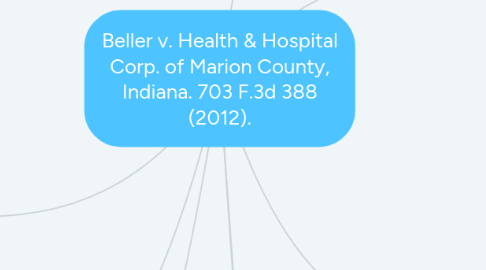
1. Influence
1.1. The case clarified the responsibility of health care institutions while operating as owners of ambulances and their responsibilities in situations where they merely own the equipment but they do not operate the services
1.2. The court clarification of the 2001 and 2003 provisions of the DHHS's EMTALA guidelines laid to rest the ambiguity and conflict in interpretation of the two provisions.
2. Importance
2.1. This case established the standard EMTALA principle that insulate health care institutions from liability even if they own emergency medical vehicles as long as such emergency vehicles are operated by coomunitywide
3. Impact
3.1. Two known cases have made reference to the Beller v. Wilshad hospital case
3.2. Gillispie v. Regional Care Hospiatl Partners, Inc validates EMTALA's provision for emergency departments not to refuse treatment to uninsured patients
3.3. Guardian v. Health and Hospital Corporation of Marion County 2016 WL 6822468, *5, S.D. Ind asserting EMTALA's provision for emergency units to stabilize patients before transferring them.
4. Facts
4.1. Plaintiffs-Melisa Welch & Joshua Beller
4.2. Defendant-Health and Hospital Corp. of Marion County d/b/a Wishard Memorial Hospital
4.3. 34 month pregnant Melissa Welch called 911 on June 14, 2001.
4.4. A Wishard ambulance was dispersed to her home and paramedics confirmed that her water broke and she had prolapsed umbilical cord
4.5. The paramedics tried to relieve pressure on the cord but after speaking with Welch's nurse, determined that Welch needed to be taken to the nearest hospital
4.6. The paramedics transported Welsh to St. Francis Beech Grove emergency room which did not have an obstetrics facility.
4.7. The physician at St. Francis Beech examined Welch and sent her with the Wishard Ambulance to St. Francis Hospital South where a C-section was performed to deliver the baby -Joshua Welch.
4.8. Joshua had suffered hypoxia which resulted in severe brain damage.
4.9. Welch alleged that Health and Hospital Corporation of Marion County (HHCMC) violated EMTALA by failing to stabilize Joshua by delivering him.
5. Issue
5.1. whether being in an ambulance owned by HHCMC should count as presenting to the hospital's property or being in the hospital's emergency room?
5.1.1. If the plaintiff is deemed to have presented to the hospital by virtue of being in the hospital's ambulance, should HHCMC be held liable for failure to stabilize Welch?
6. Rule of law
6.1. EMTALA: For all patients presenting to a hospital that has an emergency department, EMTALA requires that the hospital (1)provides medical screening to determine if there is a real emergency and (2) stabilize the patient before transferring them.
6.1.1. The EMTALA regulation in place in 2001 states: "Comes to the emergency department means ... that the individual is on the hospital property. For purposes of this section ... [p]roperty ... includes ambulances owned and operated by the hospital even if the ambulance is not on hospital grounds".
6.1.2. In 2003, the regulation was amended and explained what it means for an ambulance not to be operated by the hospital "(i) (t)he ambulance is operated under communitywide emergency medical service (EMS) protocols that direct it to transport the individual to a hospital other than the hospital that owns the ambulance ... [or] (ii) [t]he ambulance is operated at the direction of a physician who is not employed or otherwise affiliated with the hospital that owns the ambulance"
6.1.3. The original reason for EMTALA was to ensure that patients in emergency situations receive medical care regardless of their ability to pay. Hence, it is important to consider hospitals' motives of diverting patients in emergency situations.
6.2. Arrington v. Wong
6.2.1. After suffering a heart attack, a patient was being transported to the nearest hospital -Queens hospital. While communicating with a physician at the destination hospital, the paramedics were told to take the patient to Trippler Army Medical center where the patient's doctor practices. The patient died. The EMS paramedics were not Queens employees and the ambulance was not owned by Queens. The court ruled against the hospital.
7. Analysis
7.1. Plaintiffs: Argue that 2001 DHHS provision was significantly different from 2003 provision, that 2003 was a clear change to 2001 provision concerning when a patient is deemed to have come to emergency room of an hospital
7.1.1. Also argue that the district court did not conduct proper investigation to ascertain that 2003 provision was an alteration to 2001 provision
7.2. Defendants: Argue that 2003 amendment was a mere clarification of the provisions of 2001 stating a clear line of difference between ownership of an ambulance and its operation, in this case the communitywide emergency medical services is not considered as part of an hospital emergency room.
7.2.1. The 2003 provisions were issued to clarify the guidelines for uniform adoption and implementation of EMTALA policy
7.3. District Court ruled in favor of Wishard Hospital upholding that plaintiffs did not meet the criteria of having 'come to emergency room'
7.4. Court of Appeal ruled that DHHS's motive was not to alter 2001 provision but rather to clarify it.
7.5. Court of appeal further faulted defendants' argument interpreting owing and operating ambulance to mean the same thing.
7.5.1. Appeal court asserted supreme court ruling in Bowen v Georgetown University hospital, 488, U.S. 204 that administrative agency may not enact retroactive rules unless congress has granted such administrative agency powers to do so
